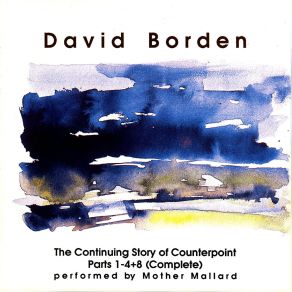The Continuing Story of Counterpoint (Parts 1-4+8 (Complete))
Download links and information about The Continuing Story of Counterpoint (Parts 1-4+8 (Complete)) by David Borden, Mother Mallard. This album was released in 1990 and it belongs to Electronica, Rock, Classical genres. It contains 5 tracks with total duration of 01:01:59 minutes.

|
|
|---|---|
| Artist: | David Borden, Mother Mallard |
| Release date: | 1990 |
| Genre: | Electronica, Rock, Classical |
| Tracks: | 5 |
| Duration: | 01:01:59 |
| Buy it NOW at: | |
| Buy on iTunes $9.99 | |
Tracks
[Edit]| No. | Title | Length |
|---|---|---|
| 1. | Part 1 | 9:31 |
| 2. | Part 2 | 10:37 |
| 3. | Part 3 | 13:31 |
| 4. | Part 4 | 19:37 |
| 5. | Part 8 | 8:43 |
Details
[Edit]David Borden's The Continuing Story of Counterpoint 12 part series (and some additional subparts) occupies three full CDs. Borden spent 11 years completing this project in which he set out to, in his words, "develop my own contrapuntal language," after getting a solid academic grounding in the work of early contrapuntal composers, and the literature of counterpoint. The earliest parts of Borden's Counterpoint project were put to paper in 1976, but Borden was experimenting with contrapuntal, minimalist language even earlier, with a pioneering, all-Moog version of the Mother Mallard ensemble, around 1970. The driving, pounding pulse of "Part 1," with the clear soprano voice of Ellen Hargis scatting over the top, has a "kosmiche" sound that would have fit right into one of German synthesizer group Tangerine Dream's better recordings. "Part 3" is really a continuation of "Part 1," with added vocal text. "Part 2 is slower and less insistent, with more intricate, interlocking rhythmic patterns. It was originally composed for two pianos, but the synthesized Mother Mallard ensemble gives it a much richer treatment. The 12 parts of his counter point series were not composed sequentially, and some parts are more involved than others. "Part 4," written seven years after Parts 1 and 3, borrows melodic materials from "Part 1," with warmer results. The dominant melodic theme is hauntingly beautiful, and somewhat reminiscent of Michael Oldfield's Tubular Bells. "Part 8" (really a different recording of "Part 8A," which appears on the next volume) features a somewhat abrasive, lower-register electric guitar which is a nice foil for the mellow electric keyboard patterns and the purity of Hargis' wordless vocals. The piece demonstrates Borden's willingness to try out new sonorities and textures within the parameters of his musical system.